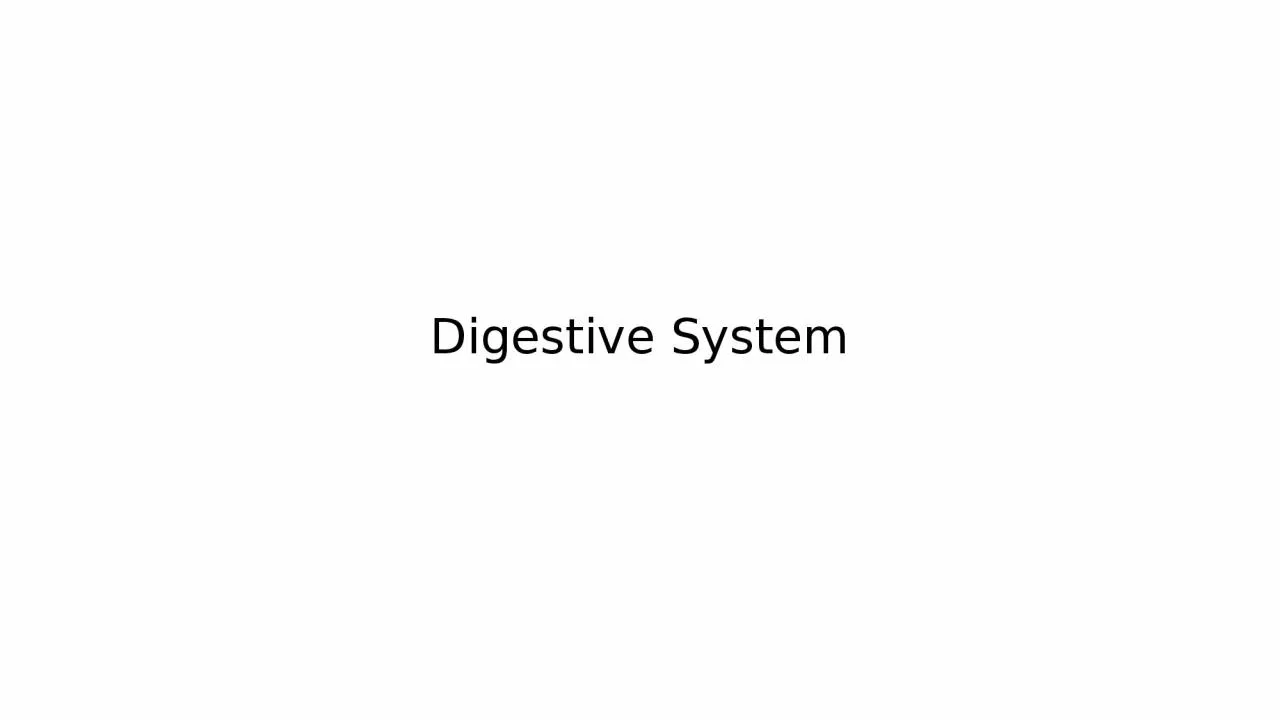

to convert food into nutrients your body needs and to rid the body of waste To do its job the system requires the cooperation of a number of different organs throughout the body including the mouth stomach intestines liver and gallbladder ID: 934743
Download Presentation The PPT/PDF document "Digestive System The digestive system ha..." is the property of its rightful owner. Permission is granted to download and print the materials on this web site for personal, non-commercial use only, and to display it on your personal computer provided you do not modify the materials and that you retain all copyright notices contained in the materials. By downloading content from our website, you accept the terms of this agreement.
Slide1
Digestive System
Slide2The digestive system has two main functions:
to convert food into nutrients your body needs, and to rid the body of waste.
To do its job, the system requires the cooperation of a number of different organs throughout the body, including the mouth, stomach, intestines, liver and gallbladder
Slide3Hey there!! Here are 10 Fun Facts +1!!
1. An adult esophagus ranges from 10 to 14 inches in length, and 1 inch in diameter.
2. We make 1 to 3 pints of saliva a day.
3. Muscles contract in waves to move the food down the
oesophagus
. This means that food would get to a person's stomach, even if they were standing on their head
4. It takes your mouth, esophagus, stomach, small intestine, large intestine, gallbladder, pancreas and liver just to digest a glass of milk..
5. An adults stomach can hold approximately 1.5 liters of material.
6. The average male will eat about 50 tons of food during his lifetime in order to sustain a weight of 150 pounds.
7. Within the colon, a typical person harbors more than 400 distinct species of bacteria
8. The liver is the largest organ in the body and performs more than 500 functions.
9. The small intestine (pronounced in-test-in) is a long tube about 1 and a half to 2 inches around, and about 22 feet long.
10. A full grown horse?? Their coiled up intestines are 89 feet long.
11. Food stays in your stomach for 2 to 3 hours.
https://sites.google.com/site/digestivesystem3051/fun-facts-2
Slide4Digestive
System
Overview
The major parts of the digestive system:
Salivary glands/Tongue-no hair on the tongue!
Pharynx
Epiglottis
Esophagus
Stomach
Small Intestine
Large Intestine
Rectum
Anus
Accessory digestive organs: liver, gallbladder, pancreas
Slide5Esophagus
From pharynx to stomach:
Salivary glands release mucus for lubrication, antimicrobial agents, and amylase to digest starch.
E
piglottis covers respiratory tract during swallowing
At end of esophagus is the lower esophageal sphincter (LES)
Propulsion of food occurs through
peristalsis
:
C
ontraction occurs behind the bolus of food and relaxation occurs ahead of the bolus of food
Slide6Stomach
Functions:
store food
initiate digestion of proteins-
peptoids
kill bacteria with the strong acidity (low pH of the gastric juice) HCLmake chymematerial passed from the stomach to the small intestine is called the
chyme
.
Slide7Small Intestine
S
mall intestine is from the pyloric sphincter to the ileocecal valve
21
ft
in length, small in diameter compared to large intestine
R
egions of the small intestine:
duodenum:
absoprtion
of carbohydrates, lipids, amino acids, Ca
2+
, iron
jejuneum
:
absopriton
of carbohydrates, lipids, amino acids, Ca
2+
, iron
ileum: absorption of bile salts, vitamin B
12
, water electrolytes.
Villi/ microvilli: increases surface area for absorption
Core of villus:
blood capillaries: absorption of monosaccharides, amino acids
lymphatic vessels (central lacteal): absorption of fats
Slide8Large Intestine
L
arge intestine is from the ileocecal valve to the anus
P
arts of the large intestine: ascending colon, transverse colon,
descending
colon, sigmoid colon,
rectum
, anal canal
contains no villi
involved in absorption of water, electrolytes, vitamins.
Contains bacteria E-Coli which serve a number of functions
absorption of vitamins (B and K)
produce small fatty acids used as energy by GI epithelial cells
help breakdown indigestible molecules
final water content of feces is about 200 ml
Slide9Liver
Major functions:
P
roduction and secretion of
bile-breaks down fats
D
etoxication
of
blood-toxins
S
ecretion and storage of glucose
P
roduction of albumin
Stores fat soluble vitamins-A,D,K,E
Liver clears substances via the bile duct in a similar manner to the way the kidney clears substances into the nephron.
Gall bladder-looks like a thumb
Gallbladder stores bile.
Slide10PANCREAS
Pancreatic juice contains:
Produces insulin-controls blood sugar level
water: H
2
O
bicarbonate: HCO
3
-
amylase: digests starch
trypsin: digests protein
lipase: digests fatty acids
Slide11Slide12Disorders:
Crohn’s Disease
Causes: unknown
Chronic inflammation bowel disease (IBD)
Effects especially the last part of the small intestine, but can affect from mouth to anus area.
Age 15-35 700,00 people in USSymptoms: Diagnosis:Abdominal pain blood testDiarrhea stool test
Fever video capsule endoscopy
Weight loss barium x-ray
Vomiting Treatment: Diet/Medication
Humira
Slide13Disorders
Gastritis-inflammation of the stomach
Hemorrhoids-inflammation of the rectum and or anus area-blood vessels.
Hernia-intestine protrudes through the abdominal wall
Ulcers-bacteria breaking down the mucin layer in the stomach exposing the inner layer-mucosa layer of the stomach.
Hepatitis-viral infections of the liver B & CDiarrhea-liquid state of waste-fecesConstipation-solid state of the waste-fecesAcid Reflux-value at the end of the esophagus-back wash into
the esophagus.
Slide14Celiac Disease
Disorder to the digestive tract caused by the autoimmune system disorder
Gluten sensitivity-protein found in wheat, rye, barley
Symptoms:
Gas
BloatingCrampsDiarrheaCommon foods:Pasta’s, breads, crackers, seasonings, spices and some fried foods.No cure!
Treatment: Diet/Fruits vegetables, seeds, fish, dairy products
Diagnosis: Blood test for antibodies
Slide15http://www.nationalgeographic.com/science/health-and-human-body/human-body/digestive-system/
Explanation of the digestive system